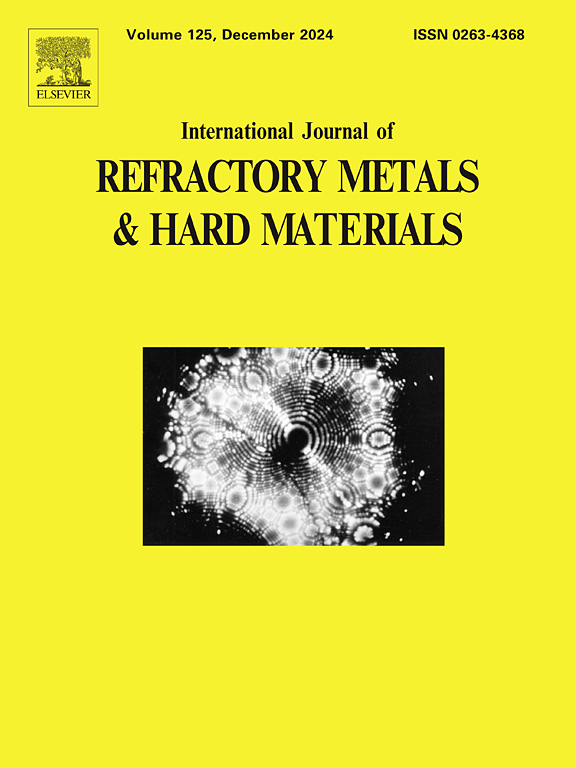多组分合金粘结剂对PCD中金刚石骨架形成的影响
IF 4.2
2区 材料科学
Q2 MATERIALS SCIENCE, MULTIDISCIPLINARY
International Journal of Refractory Metals & Hard Materials
Pub Date : 2025-07-16
DOI:10.1016/j.ijrmhm.2025.107329
引用次数: 0
摘要
hpht合成的多晶金刚石(PCD)具有超高的硬度,广泛应用于切削和钻井工具。机械强度主要取决于金刚石骨架的形成,受合金粘结剂的显著影响。本研究采用Co60Ni30Cr6C4、(Co60Ni30Cr6C4)94Ti3Al3和(Co60Ni30Cr6C4)90Ti2.5Zr2.5Al5 3种多组分合金粘结剂在高温条件下制备了pcd。结果表明,(Co60Ni30Cr6C4)90Ti2.5Zr2.5Al5-PCD的横向断裂强度最高,约为891 MPa,分别比Co60Ni30Cr6C4和(Co60Ni30Cr6C4)94Ti3Al3-PCD高35.6%和13.8%。这种改进归因于形成了一个连续且相互连接的金刚石骨架,很可能是由于增加了细金刚石颗粒的产生,有效地桥接了这些颗粒。高温条件下(Co60Ni30Cr6C4)90Ti2.5Zr2.5Al5-PCD中形成的碳化物可以强化金刚石-粘结剂的界面结合。该研究为在高温高压下合成PCD的新型合金粘结剂的设计提供了有益的见解,同时也加深了对PCD内金刚石骨架形成机制的理解。本文章由计算机程序翻译,如有差异,请以英文原文为准。

Influence of multi-component alloy binder on diamond skeleton formation in PCD
HPHT-synthesized polycrystalline diamonds (PCD) exhibit ultrahigh hardness, widely used in cutting and drilling tools. The mechanical strength, primarily dependent on diamond skeleton formation, is significantly influenced by the alloy binder. In this study, PCDs were prepared using 3 multi-component alloy binders: Co60Ni30Cr6C4, (Co60Ni30Cr6C4)94Ti3Al3, and (Co60Ni30Cr6C4)90Ti2.5Zr2.5Al5 under HPHT conditions. The results show that (Co60Ni30Cr6C4)90Ti2.5Zr2.5Al5-PCD achieves the highest transverse rupture strength (approximately 891 MPa), which is 35.6 % and 13.8 % higher than that of Co60Ni30Cr6C4-PCD and (Co60Ni30Cr6C4)94Ti3Al3-PCD, respectively. This improvement is attributed to the formation of a well continuous and interconnected diamond skeleton, most probably facilitated by increased generation of fine diamond grains which effectively bridge these particles. Additionally, the carbides formed under HPHT conditions in the (Co60Ni30Cr6C4)90Ti2.5Zr2.5Al5-PCD can strengthen diamond-binder interfacial bonding. This study provides useful insights for designing new alloy binder to synthesize PCD under HPHT while also deepening the understanding of the formation mechanisms of the diamond skeleton within PCD.
求助全文
通过发布文献求助,成功后即可免费获取论文全文。
去求助
来源期刊
CiteScore
7.00
自引率
13.90%
发文量
236
审稿时长
35 days
期刊介绍:
The International Journal of Refractory Metals and Hard Materials (IJRMHM) publishes original research articles concerned with all aspects of refractory metals and hard materials. Refractory metals are defined as metals with melting points higher than 1800 °C. These are tungsten, molybdenum, chromium, tantalum, niobium, hafnium, and rhenium, as well as many compounds and alloys based thereupon. Hard materials that are included in the scope of this journal are defined as materials with hardness values higher than 1000 kg/mm2, primarily intended for applications as manufacturing tools or wear resistant components in mechanical systems. Thus they encompass carbides, nitrides and borides of metals, and related compounds. A special focus of this journal is put on the family of hardmetals, which is also known as cemented tungsten carbide, and cermets which are based on titanium carbide and carbonitrides with or without a metal binder. Ceramics and superhard materials including diamond and cubic boron nitride may also be accepted provided the subject material is presented as hard materials as defined above.

 求助内容:
求助内容: 应助结果提醒方式:
应助结果提醒方式:


